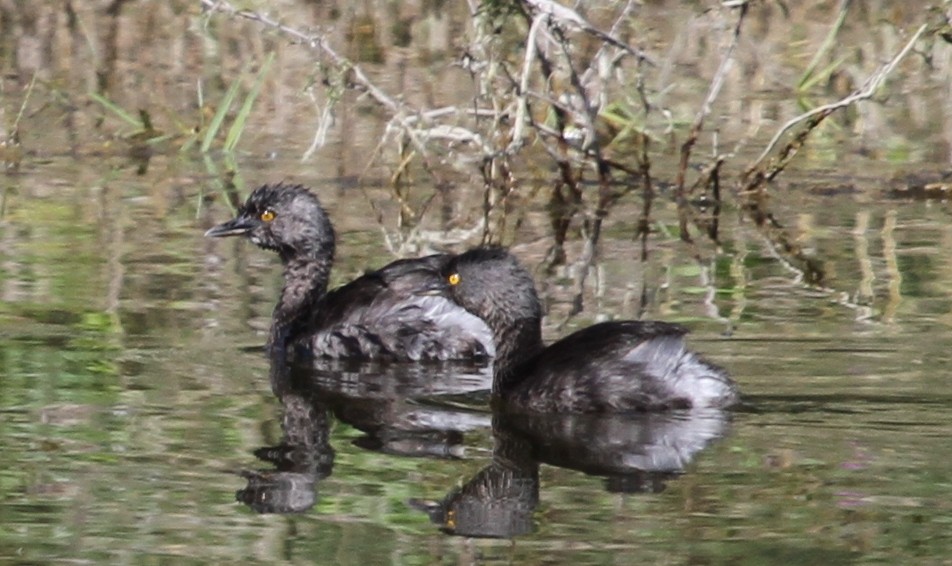Least Grebe
A species of Small Grebes Scientific name : Tachybaptus dominicus Genus : Small Grebes
Least Grebe, A species of Small Grebes
Botanical name: Tachybaptus dominicus
Genus: Small Grebes
Content
Description General Info
 Photo By panza-rayada , used under CC-BY-SA-3.0 /Cropped and compressed from original
Photo By panza-rayada , used under CC-BY-SA-3.0 /Cropped and compressed from original Description
The least grebe ranges in length from 21–27 cm (8.3–10.6 in) (depending on the subspecies) and in weight from 112–180 g (4.0–6.3 oz). Weights are variable based on region and subspecies, being smaller in Panama, where males weighed a mean of 129 g (4.6 oz) against the females 116 g (4.1 oz) and larger in the West Indies, where the sexes weigh a mean of 161 g (5.7 oz) and 133 g (4.7 oz), respectively. In Texas, size is intermediate at 139 g (4.9 oz) and 122 g (4.3 oz). Even in the largest races, the least grebe is still smaller and lighter than any other grebe species. Like all grebes, its legs are set far back on its body and it cannot walk well, though it is an excellent swimmer and diver. Small and plump, with a fairly short, sharp-pointed beak and bright yellow eyes, it typically appears quite dark all over. The breeding adult is brownish grey above with a darker blackish crown and throat. It has a brownish chest and pale underparts. It shows a white wing patch in flight. Non-breeding birds are paler with a whitish throat, and immatures are paler and greyer than adults. Unlike all other members of its genus, it lacks any chestnut coloring on its neck. 
Size
23-25 cm (9-10 in)
Life Expectancy
3-15 years
Nest Placement
Floating
Clutch Size
3 - 7 eggs
Feeding Habits
Least Grebe primarily consumes insects and small vertebrates, including various waterbugs, beetle species, dragonflies, damselflies, ants, spiders, crayfish, crabs, frogs, tadpoles, and small fish. They forage by picking prey from water surfaces and vegetation or diving to chase aquatic prey. Least Grebe also employs aerial snaps at flying insects and swallows some feathers, forming a protective stomach plug against sharp bones.
Habitat
Least Grebe inhabit aquatic environments, predominantly favoring freshwater and brackish waters such as lowland ponds, marshes, small lakes, and mangrove swamps. These birds thrive up to 8,200 feet in altitude, in areas rich in emergent and aquatic vegetation essential for foraging and protection. Their adaptable habitat range may extend to temporary ponds in arid areas post-rainfall, while typically avoiding saltwater ecosystems.
Nest Behavior
Least Grebe typically build their nests near water, with strategic timing and egg-laying synchronized to local conditions. Both parents share responsibilities in constructing the nest, incubating the eggs, and rearing the young, showcasing a cooperative breeding effort.
Nest Characteristics
The nest of least Grebe is a mound constructed from wet, decaying plant material, averaging 9.8 inches in diameter. It features a central depression measuring 2.8 inches across and 0.8 inches deep, situated near the water's edge and often anchored to vegetation or the bottom.
Dite type
Aquatic invertebrate eater
General Info
Feeding Habits
Bird food type
Sounds
Call
Recording location: Venezuela
Call
Recording location: Venezuela
Behavior
Least Grebe display distinct daily behavioral patterns, including engaging in memorable courtship rituals at any time during the year. Notably, pairs vocalize a rapid trill to solidify their strong monogamous bonds. These remarkably social birds perform a unique 'rushing ceremony' wherein pairs energetically paddle across the water surface, coupled with attention-catching vocal calls. Both genders partake equally in nesting activities, incubating eggs and nurturing their chicks. The young are often seen hitching a ride on their parents' backs, secure even during underwater dives—a quintessential behavior of least Grebe.
Species Status
Not globally threatened.